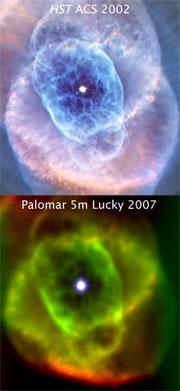 The Cat’s Eye Nebula, snapped by Hubble (top) and the Lucky camera (bottom)STScI/Cambridge/Caltech
The Cat’s Eye Nebula, snapped by Hubble (top) and the Lucky camera (bottom)STScI/Cambridge/CaltechEarlier this week, a group of researchers at Cambridge University and the California Institute of Technology in Pasadena reportedly released the sharpest images of space ever taken. The team boasted that the images were twice as good as those taken by the Hubble Space Telescope. Moreover, the Earth-based camera used to take them is 50,000 times cheaper than Hubble.
But things aren't so clear-cut: Hubble scientists have fired back with a set of images they claim show their space telescope is the better instrument. News@nature.com tries to bring the debate into focus.
What exactly is meant by the "clearest" or "sharpest" image of space?
This comes down to how finely you can see detail in a section of sky. Astronomers measure such resolution in angular units known as 'arcseconds' (as seen from Earth, a 2-kilometre-wide crater on the surface of the Moon measures about 1 arcsecond). The resolution of a telescope is usually measured in fractions of an arcsecond — and the smaller the better.
So how did this new camera do?
In certain cases, the 'Lucky Camera', as it's called, was able to resolve down to about 50 milliarcseconds, according to Craig Mackay, a Cambridge astronomer who helped to develop it. By comparison, Mackay says, the Hubble's cameras usually operate around the 100 milliarcsecond range.
How was it able to do it?
The Lucky Camera works by taking a large number of images very quickly. The speed helps to correct for the twinkle of the starlight as it passes through the atmosphere. A computer then adds all the best images together to create a single, super-clear image. The camera's big innovation is a detector with a very low interference from noise, which makes sure that the individual images are clean enough to be added atop one another.
So it sounds like the Lucky Camera is the clear winner, right?
Not necessarily, says Matt Mountain, director of the Space Telescope Science Institute in Baltimore, Maryland. It's true, he says, that the camera can produce super-sharp images. But to do so it has to throw out all the bad photos it takes, which can be up to 99% of the pictures. That means that to gather the same number of stellar photons, you have to sit watching a section of the sky for a lot longer with this camera.
But the end pictures are still sharper, right?
It depends what you're taking a picture of. The Lucky Camera can only reach its optimum resolution when looking in very narrow fields of view at fairly bright objects. The small field of view allows the camera to snap the photos quickly, and brightness means fewer pictures are needed for a good view. For larger, less-bright objects, the Hubble still wins.
Many of the initial pictures that were published by the Lucky team were of the Cat's Eye Nebula — a complex shell of gas and plasma formed by a dying star that measures about 20 arcseconds in our sky.
These snaps do indeed look crystal clear, especially when compared with that of a standard ground-based telescope. But the Hubble Space Telescope can produce a much sharper image of this relatively large object (see picture).
So where did the "sharpest image of space" claim come from?
ADVERTISEMENT
Well, says Mackay, perhaps their press release got a little out of hand. The team wanted the world to know about their camera, and this seemed like a simple, provocative way to make the point. But, he admits, the press release "did kind of hype it up".
What's the bottom line here?
The Lucky Camera really is an innovative new camera design with exciting potential for taking some really sharp pictures. But it's not going to replace the Hubble.
Visit our thistheclearestpicture_o.html">newsblog to read and post comments about this story.
